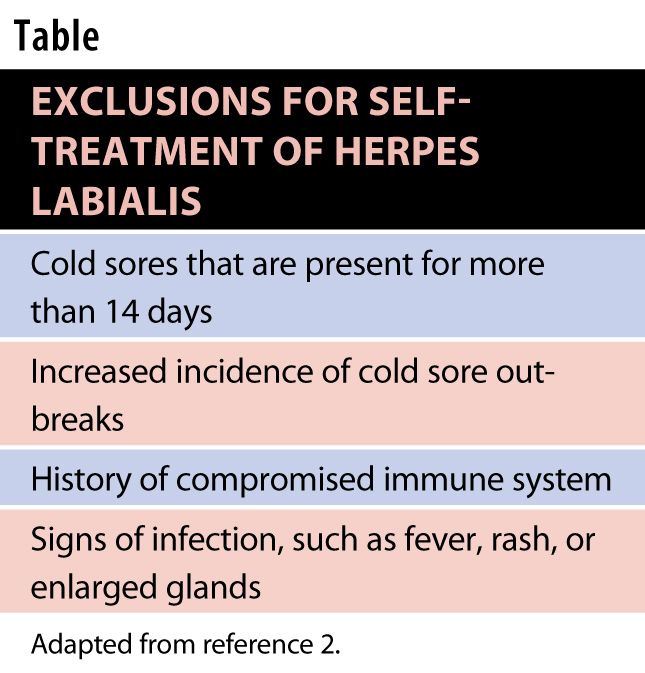Managing Cold Sores
Herpes simplex labialis can be controlled with proper treatment and use of OTC products. The pharmacist can play a key role in identifying patients who should seek further medical treatment from their physicians.
Herpes simplex labialis (HSL), also known as cold sores or fever blisters, is a common disease typically caused by infections of the mouth area with the herpes simplex virus 1 (HSV-1). Another form of the virus, herpes simplex virus 2 (HSV-2), is primarily responsible for causing genital herpes.1,2 Either form of the virus can cause cold sores or genital herpes if there is contact with the skin.1,2
Statistics show that between 50% and 98% of the US adult population is infected with HSV-1; many patients who have the virus never develop cold sores, however.1 Once an individual becomes infected, the virus remains in his or her system for life. Most individuals will experience periods of dormancy or reactivation phases, and an estimated 30% to 40% of those who are exposed to HSV will develop recurrent infections.2 The majority of cold sore outbreaks are treatable and heal within 10 to 14 days without scarring or other complications (Table).2
Triggers
Numerous factors may increase the frequency of HSL outbreaks, including1-4:

- Stress/fatigue
- Ultraviolet radiation due to extreme sun exposure
- Exposure to cold weather
- Fever and/or infections due to colds or influenza
- Trauma due to recent dental work
- Menstruation, pregnancy, or other conditions associated with hormonal changes
- Factors that may compromise the immune system (eg, chemotherapy, radiation therapy, or immunosuppressant agents)
- Food allergies
Signs and Symptoms
Typically, an outbreak of HSL goes through various stages, with each having distinct characteristics. In the initial stage of an outbreak, cold sores are preceded by a prodrome.2,5 During this phase, the individual will experience a burning or tingling sensation, and/or itching approximately 48 hours prior to the appearance of a cold sore lesion.2,5 Other symptoms during this stage may include pain, fever, and swollen lymph glands. Cold sores usually appear first as small erythematous vesicles, which range in diameter from 1 mm to 3 mm, and can combine to form a larger lesion.2,5 As the lesions mature, a crust forms over the vesicles that have erupted. If pus appears under the crusted area, a secondary infection may be present. 2,5
Treatment of HSL
An outbreak of HSL can negatively impact several aspects of an individual’s quality of life, including physical, social, and emotional well-being. Pharmacists can provide key information on the most effective treatments for managing HSL, and preventive measures that can help decrease the risk of future outbreaks. The primary goals in treating HSL are to relieve pain and discomfort, prevent transmission to others, and prevent further complications or infections.2
Currently Abreva (docosanol 10%), manufactured by GlaxoSmithKline, is the only FDA-approved nonprescription product proved to shorten healing time and reduce both the severity and duration of symptoms. Docosanol works by inhibiting direct fusion between the herpes virus and the human cell plasma membrane, thus averting viral replication.2,3 Docosanal is intended for external use only for individuals 12 years and older. It should be applied 5 times a day, beginning at the first sign of outbreak, until the sore is gone. are not indicated to reduce duration of symptoms.2 Topical triple antibiotic ointments or systemic antibiotics may be used if there are any signs of a secondary infection. 2 Patients should be advised to discuss the need for antibiotics with their primary health care provider.
Pharmacists can also remind patients that in addition to using topical nonprescription products, the following measures can be implemented to better manage and prevent the transmission of HSL outbreaks1,2,6:
- Apply a cool, wet compress or ice to the affected area at least 2 to 3 times a day for 15 to 20 minutes to reduce swelling or erythema.
- During outbreaks, avoid foods that may aggravate cold sores (eg, acidic foods).
- If not contraindicated, consider the use of an OTC analgesic to alleviate pain.
- Keep lesions clean by routinely cleansing the affected area with mild soap solution.
- Use skin protectants to keep lesions moist, as drying and cracking may make the lesions more susceptible to secondary bacterial infection.
- Wash hands regularly with warm water and soap to prevent transmission or spread of the virus.
- Apply sunscreen on the lips and face before exposure to sun.
- Avoid direct contact with others when blisters are present and avoid sharing personal items (eg, towels, razors, silverware) to decrease the risk of transmission.
- When possible, avoid known triggers.
The Role of the Pharmacist
When counseling patients about the proper use of these products, it is imperative to emphasize the contagious nature of HSL lesions and discuss ways to prevent or reduce transmission to others. Moreover, pharmacists play a key role in identifying patients with HSL lesions that may require further medical treatment from their primary health care provider.
Ms. Terrie is a clinical pharmacy writer based in Haymarket, Virginia.
References
- About cold sores. Abreva Pharmacist Web site. www.abrevapharmacist.com/AboutCS_etiology.aspx. Accessed June 28, 2011.
- Marcinak M. Oral pain and discomfort. In: Berardi R, Newton G, McDermott JH, et al. Handbook of Nonprescription Drugs. 16th ed. Washington, DC: American Pharmacists Association; 2009:616-619.
- Cold sore basics. Abreva Web site. www.abreva.com/basics_What.aspx. Accessed June 28, 2011.
- Cold sores. Medline Plus Web site. www.nlm.nih.gov/medlineplus/coldsores.html. Accessed June 28, 2011.
- Pathophysiology: the five stages of a cold sore outbreak. Abreva Pharmacist Web site. www.abrevapharmacist.com/AboutCS_path.aspx. Accessed June 28, 2011.
- Cold sores. Mayo Clinic Web site. www.mayoclinic.com/health/cold-sore/DS00358/DSECTION=3. Accessed June 28, 2011.

